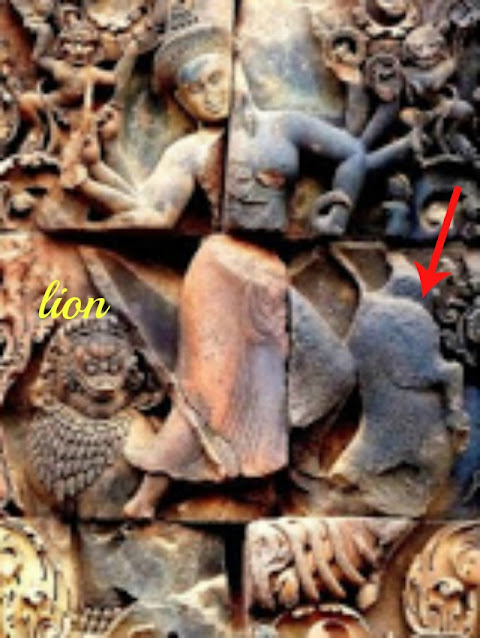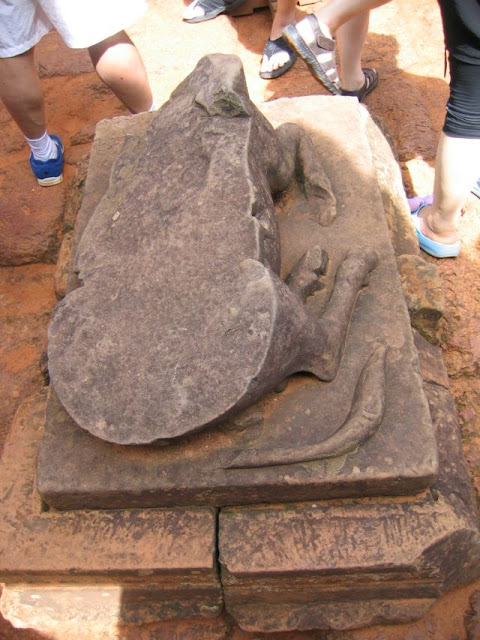Once inside the inner enclosure, two identical constructions are seen. These are called the
two libraries. From where you stand, the one on the left side is the
southern library and on to your right is the
northern library. Each library has two pediments one on the
east and the other on
west containing scenes from Hindu mythology. The pediments need to be seen to believed. Behind the libraries are seen three towers of the shrine.
entrance to innermost enclosure
Figure 2
The libraries are made of laterite, pink sandstone and wood. They have false doors towards east and are open on the west facing the temple entrance.
two libraries
Southern library:
The library has two pediments, one facing east and the other west. Pediments in both directions have beautifully illustrated scenes.
The
east pediment (#a in Figure 2 above) depicts a scene depicting Ravana and Lord Shiva.
full view of southern library
false door
Most of the temples opened in one direction (east). To maintain symmetry false or fake doors were made which had no opening. The above picture is below the lintel and is flanked by colonettes.
The above scene on tympanum from Ramayana is known as Ravananugraha (रावणानुग्रह), Ravana and anugraha: to plead. Ravana pleads Shiva to remove his toe and set him free.
It shows Lord Shiva (#1) in Abhaymudra,(no fear gesture) with his consort, Parvati (#2) or Uma on Mount Kailash, his abode. Ravana (#4), the King of Lanka who was a great devotee of Lord Shiva got egoistic and under that impression tried to shake Mount Kailash where Lord Shiva resides. Lord Shiva molifies him by just placing his toe over him and trapping him under Kailash for thousands of years. Trapped, Ravana cried (Raav (राव) which means crying) and sang praises of Shiva who finally blessed him. Henceforth, Ravana was popularly called by this name. His name was actually Dashgriva (दशग्रीव), das: ten, griva: neck, a person with ten necks. Ravana did not physically have ten heads, he had knowledge about the ten directions.
Lord Shiva granted him an invincible sword (#7).
Below Shiva are seen his devotees (#3) who are worried about Ravana's action. Then are ganas (गण) (#5), his attendants mostly with heads of animals. Terrified animals can be seen running away (#6)
The scene is symbolic of the natural force of earthquakes.
a close up section of the top part with Uma/Parvati sitting on left lap of Shiva
lower section of typanum, how intricate and detailed the etching is
In the lower section where Ravana's head is facing we see
Garuda, and next to him is
Ganesha and on left side is
Hayagriva, Vishnu with the head of a horse, and
Hanuman in the extreme corner.
Garuda in corner of pediment
The West Pediment:
On the opposite side (
b), the western pediment illustrates a scene of Kamdeva shooting an arrow of love at Shiva. Kamadeva is the God of love,
Kama: desire, love and
deva: god.
According to Shiva Purana, after Lord Shiva's wife, Sati whom he loved immensely, died Shiva vowed to lead a life of ascetic. This troubled the Gods who wanted Shiva to marry as his son alone could kill the demon king,
Tarakasur.
Kaamdeva, the god of love was sent to Shiva to shoot his arrow of love at Shiva so that he could marry Parvati. When Shiva came to know that Kaamdeva had interfered, he opened his third eye and reduced him to ashes.
Later with the intervention of Gods, Kaamdeva was revived.
In the above scene we see Lord Shiva (#
1) giving a rosary to Parvati (#
2). Kaamdeva (#
3) is ready to shoot the arrow of love at Shiva. In the lower section we ascetics (#4) and below that his ganas (#
5).
In the lowermost section are the worldly people (#
6).
On the side is a small scene again of Narsimha avatar slaying Hiranyakashyapu (#
7).
makar on side
Makar is a mythological creature with the body of a serpent, has a trunk like elephant. The head is like a dragon or a mix of lion and crocodile.
Northern library:
The pediment on east (
c) of this library depicts a scene from Mahabharata of fire in
Khandava forest (खांडव वन )
Narsimha avatar on the side
In the above part of tympanum, Indra (#1) seen astride his mount the elephant, Airavat. Takshak (#2), the king of snakes is seen in the center. Since, Indra was the protective deity of snakes, he agreed to help the snakes by dousing the fire with water. He unleashed torrential rains (#3) to put out the fire. Geese (#5) support the arrows to prevent them from falling down.
The lower part of tympanum shows Arjun (#6) showering arrows to block the water from entering the forest. Arjun (#6) makes a roof of arrows (#4) to stop the water from entering the forest (#8).
Frightened animals (#9) take shelter in the forest (#8). Demons (#10) running away.
Terrified demons (#
10) running away.
In the center (#
7) are said to be Krishna and his brother Balram.
On the lintel is Indra on Airawat
The
western pediment of northern library shows Krishna (
#1 in figure 3 below) slaying his uncle (
#2) Kansa. This scene is taken from
Shrimad Bhagwatpurana (#
d )
Krishna slaying Kamsa in the latter's palace which is depicted in so much detail
Garuda with head missing and Narasimha in the corner of pediment
Figure 3
Kansa was the ruler of Mathura and maternal uncle of Krishna and his brother Balrama. He was an oppressive ruler and it was prophesied by Sage Narada that he would be killed by his sister's eighth child. Terrified by this news, Kansa imprisoned his sister and her husband. He killed her children as soon as they were born.
When Lord Krishna was born, due to heavenly interventions, all guards of the prison went off to sleep, the prison gates opened and Vasudeva, Krishna's father took the child out to his friend Nanda in Gokul and exchanged his son for his daughter. Once back in the prison, everything came back to normal.
The next morning when Kansa came to kill the new born child, the child transformed into Goddess Shakti and told Kansa that the person to end his life was already born.
Coming to know of this, Kansa made various attempts to kill Krishna but to no avail. Finally, Kansa on the pretext of killing Krishna invited him to his palace. He sent elephants to trample him, demons to wrestle with him. Overpowering all these, Krishna killed Kansa.
The above scene illustrates Krishna (
#1 in Figure 3 above) slaying Kamsa (
#2).
The day is still celebrated in Mathura to mark an end to the oppressive rule of Kansa.
Just behind the libraries is the Central Sanctuary.
contd. to
Central Sanctuary







 Yaksha are seen in front of central shrine facing east and other two on the west side (rear side) of the same shrine.
Yaksha are seen in front of central shrine facing east and other two on the west side (rear side) of the same shrine. Other guardian figures have human torso with head of a lion, monkey or garuda. Guardian figure with monkey head (Hanuman) is seen on the north and south of mandapa of the central shrine.
Other guardian figures have human torso with head of a lion, monkey or garuda. Guardian figure with monkey head (Hanuman) is seen on the north and south of mandapa of the central shrine.































































